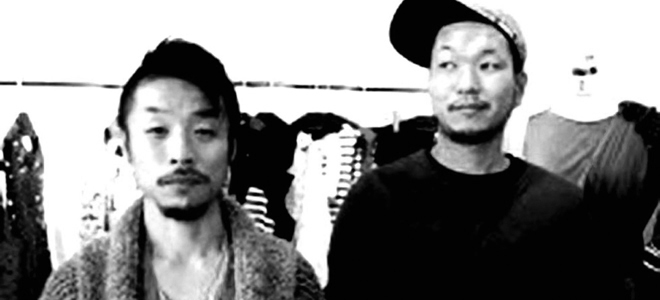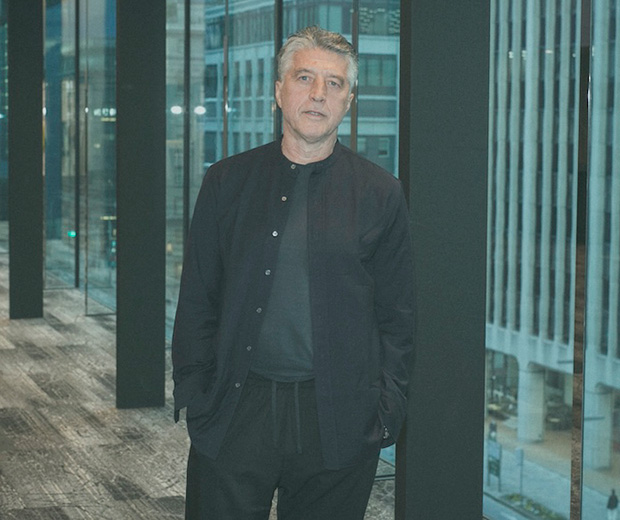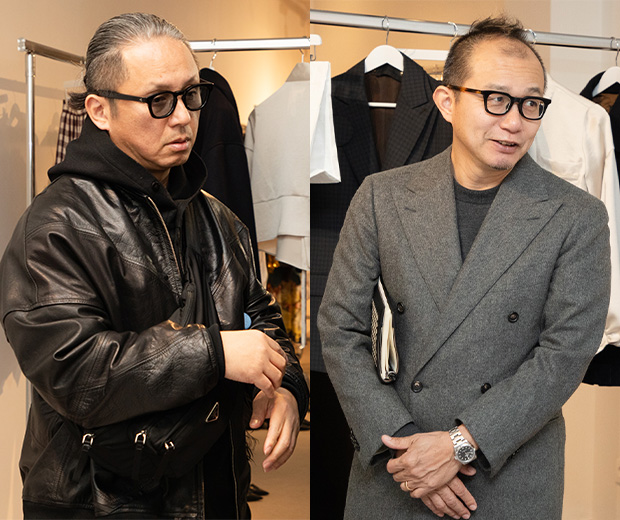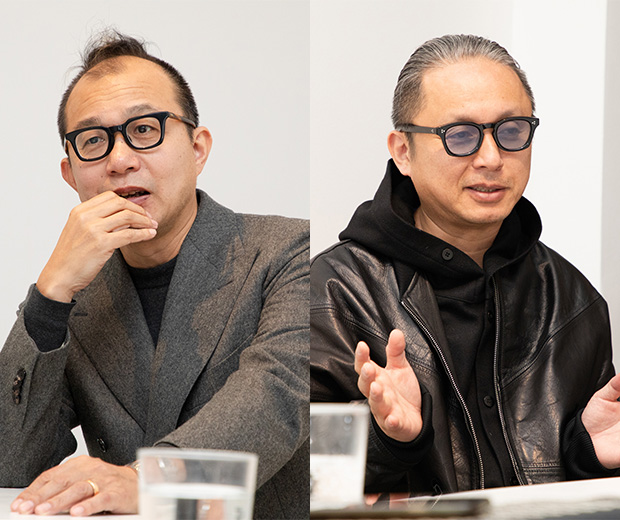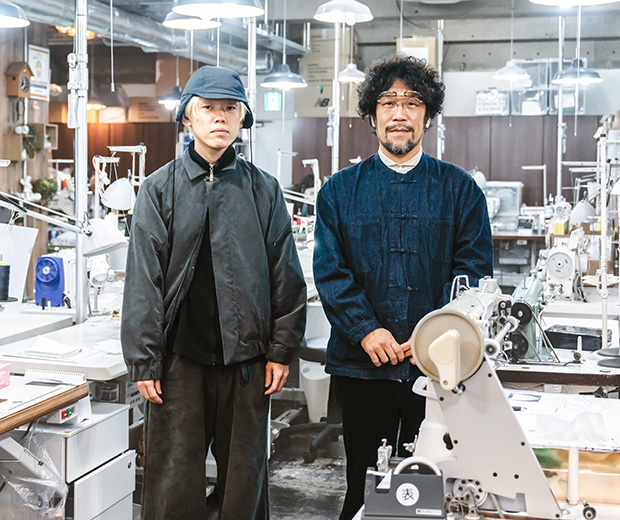Joga Naoto / Tamaki Hiroto
Et momonakia shined in the spotlight during the last season’s Fashion Week with their installation themed on the backstage of runway shows. The collections created by Joga Naoto and Tamaki Hiroto, both designers having experience as assistants to top French brands, have a wide fan base among women with their dress styles combining their definitive sensitivity and skills with a distinctive sense of playfulness. We sat down with et momonakia who’ve been even more at the center of focus after being selected as a “Mercedes-Benz Presents Designer” during the 2013 Spring/Summer Fashion Week.
Could you tell us how you honestly felt when you were selected as a Mercedes-Benz Presents Designer?
Tamaki: I am honored to have been chosen. There will probably be more people that will see our work now, and that’s really motivating. I’m happy because I think it’s because people saw value in our previous presentation, and this will be another opportunity to bring it to another higher level.
Joga: This is the first time for me to take on something this big with people from the outside, so I want to cooperate well with them to create a great worldview.
What will the collection be like?
Tamaki: We don’t plan to make changes the clothes we make, but we want to do something amazing with the presentation, working off of the Mercedes-Benz Connection space.
Last season you had an installation themed on the backstage of runway shows, so you will not have a runway show this time either?
Joga: Even if we tried to do a runway show at this point, it will be a mediocre attempt, so we think we shouldn’t to try just yet.
Tamaki: Last time, we chose the theme of backstage and communicated that “We want to do a runway show!” So it’s really too early to do a show at this time. If we are going to have one, I’d like it to have it after we have some experience as a brand and when everything is firm under us.

How do you go about thinking about each season’s collection?
Tamaki: We always start off writing a bunch of circles on a piece of paper and fill them in with words.
Joga: For example, we first write out the number of items like “3 coats” or “2 dresses”. We check what the overall collection will look like, add what’s necessary and eliminate what is not to create a collection.
Tamaki: We don’t want to start off by deciding on some intellectual concept. We always use one of the song titles from Yamaguchi Momoe or Nakamori Akina as a theme, so we loosely mold it to that, but that’s about it.
Joga: The theme may be decided afterwards, or if it’s a strong song title, we may think of motifs based on it, but our items are mainly dresses, so many of them are complete standalone and not about themes or styling. So I think that they’re not something that only fits a certain type of woman, but that each item has an image of a different type of woman.
Your brand name is based on Yamaguchi Momoe and Nakamori Akina that you just mentioned, right?
Tamaki: Joga originally loved them. For me, I started off with indirectly listening to Nakamori Akina through my parents.
Joga: I watched Nakamori Akina in real time since I was in grade school, and I loved her stage costume. It was a proper ‘80s idol wardrobe. But in the late ’90s, Puffy debuted and this trend saying female artists should dress casually grew stronger, so stage costumes gradually waned… But recently with the rise of AKB48 and other groups, we’re seeing more and more wardrobes that are similar to stage costumes at the height of the ‘80s idol, and so it’s getting interesting again after that long break.
Tamaki: I think our brand’s feature is that we incorporate the essences of stage wardrobe or one-of-a-kind wardrobe.
What was your initial vision when starting the brand?
Joga: We started off thinking it would be great to start Japan’s first luxury brand, which was really too optimistic in hindsight. In other countries there are many brands like Prada, Dior, and Lanvin, but in Japan, we have a lot of brands popular with younger people, but no luxury brands for fashion-conscious adults. I wanted to create something like that.
Tamaki: It’s not that I hate casual, but I felt that Japan is saturated with it. For example, I think it’s fine to be wearing jeans for most of the 365 days in a year, but maybe it’s also good to have a few more days when you wear a dress. In Japan, there’s an established notion that you can only wear dresses to a wedding reception or something like that. But we don’t just make satin dresses, but offer ones you can wear daily, and I think it would be great if there were more opportunities to wear that kind of clothing.
Do you also have the mindset to change Japanese and their fashion?
Joga: We don’t have such grand notions. They’re clothes, so we want to keep creating items that we simply think are beautiful. So it really boils down to whether that is accepted by people or not. Customers are free to choose what they want. Within that, we do offer our ideas and create our items convinced that women will be more beautiful when they wear them, but we don’t want to push that on to people. It’s the same with the idea of not deciding on a concept. It makes sense if its philosophy or literature, but we don’t think it’s quite right for us to force our concept of clothing on people wearing them.
Tamaki: I think that it is one approach for a brand, but for us, we want to create clothes that women will fall in love with at first sight. We share that idea, so even though we don’t talk about clothes normally at all, we have been able to continue on like we have.
Joga: Recently, many people wear clothes to cover their bodies up instead of to look beautiful. But I don’t think it has to be casual, and I have a strong conviction of wanting people to become beautiful by wearing our clothes for fun and work.
You do have the theme “boundary between playfulness and elegance”.
Joga: This is not a concept for the brand, but it has always been a guiding theme for it. If it’s just “elegance”, the audience’s age will be too high and if it’s just “play”, it’s too young, so we want to aim somewhere right in between, making clothes that anyone can wear.
Tamaki: It’s fun to create while thinking about that balance; you can casually add playfulness too. Sometimes we can go overboard, but that’s also good because that’s us. We don’t decide on a clear theme for each season and only keep focusing on this “boundary between playfulness and elegance,” but our moods at each particular time funnel into to and we end up with something different each time.
You’re not very conscious of trends?
Tamaki: No. I don’t know what the trend colors are and don’t look at other brands’ clothes.
Joga: We look at Chanel and other brands we like, but it’s just a fan. We make our clothes thinking that what can be worn now can be worn both ten years ago and ten year from now.
There are no competition brands to et momonakia that come to mind, and it seems that you’re walking on your own path including the fact that you’re based in Kyoto.
Tamaki: There are no competing brands. I think the general impression people have of Tokyo brands are casual and cute, and we did not want to be placed in that category or be pulled into that image.
Joga: Tokyo has a strong image of being a young scene, but we wanted to go for a more mature image.
Tamaki: That being said, there are many disadvantages of not being in Tokyo. For example, it’s still difficult for us to go as a standalone brand, so we need to work with external parties and bring that back to the brand. But that is easier to do in Tokyo.
Joga: There are those opportunities in Osaka, but we don’t really take action too much…
Tamaki: That’s why we hope that many people will see our presentation as the Mercedes-Benz Presents Designer, and come speak to us. We’ve been given a really great opportunity including this anticipation we feel because we want to firstly build a stronger foundation in Japan.
Joga: Once we are stronger in Japan, we hope to expand internationally, especially to China or Taiwan.

